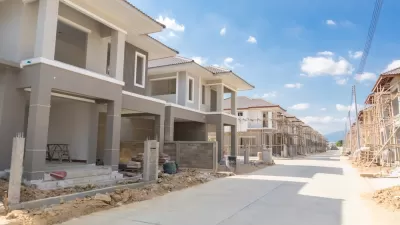As communities across the country work to address massive housing shortage and affordability issues, a new guide from the American Planning Association and the National League of Cities can help decision-makers chart a clear path forward.

The American Planning Association, in partnership with the National League of Cities, recently released a free playbook for local elected officials and planners who are looking to boost the supply of housing in their communities. The 92-page “Housing Accelerator Playbook” outlines current, multi-pronged housing supply and affordability challenges faced by cities, towns, and villages across the United States — including construction, finance, land use regulations, and infrastructure — outlines a systems approach to address them, and provides a bevy of actionable strategies and real-life case studies to help communities chart their own paths forward.
In its own words, the playbook is “meant to serve as a starting point for engagement and alignment through public-private partnerships to produce attainable and locally driven plans of action that account for differences in local capacities and market conditions.” Within this resource, APA and NLC have compiled a wealth of expertise and thought leadership to offer a menu of effective strategies from which elected officials and local planners can choose according to their communities’ unique situations and needs. If you are a local housing policy decision-maker and haven’t already checked this resource out, it is definitely worth a gander.
FULL STORY: Housing Supply Accelerator Playbook Provides Solutions for Addressing Nation’s Housing Supply Crisis

Planetizen Federal Action Tracker
A weekly monitor of how Trump’s orders and actions are impacting planners and planning in America.

Congressman Proposes Bill to Rename DC Metro “Trump Train”
The Make Autorail Great Again Act would withhold federal funding to the system until the Washington Metropolitan Area Transit Authority (WMATA), rebrands as the Washington Metropolitan Authority for Greater Access (WMAGA).

The Simple Legislative Tool Transforming Vacant Downtowns
In California, Michigan and Georgia, an easy win is bringing dollars — and delight — back to city centers.

The States Losing Rural Delivery Rooms at an Alarming Pace
In some states, as few as 9% of rural hospitals still deliver babies. As a result, rising pre-term births, no adequate pre-term care and harrowing close calls are a growing reality.

The Small South Asian Republic Going all in on EVs
Thanks to one simple policy change less than five years ago, 65% of new cars in this Himalayan country are now electric.

DC Backpedals on Bike Lane Protection, Swaps Barriers for Paint
Citing aesthetic concerns, the city is removing the concrete barriers and flexposts that once separated Arizona Avenue cyclists from motor vehicles.
Urban Design for Planners 1: Software Tools
This six-course series explores essential urban design concepts using open source software and equips planners with the tools they need to participate fully in the urban design process.
Planning for Universal Design
Learn the tools for implementing Universal Design in planning regulations.
Smith Gee Studio
City of Charlotte
City of Camden Redevelopment Agency
City of Astoria
Transportation Research & Education Center (TREC) at Portland State University
US High Speed Rail Association
City of Camden Redevelopment Agency
Municipality of Princeton (NJ)





























